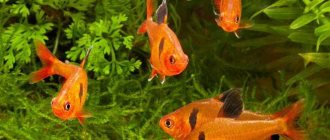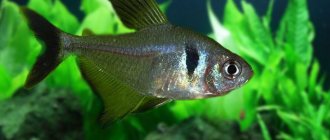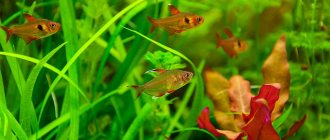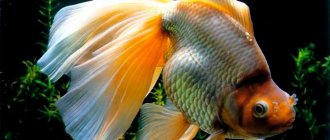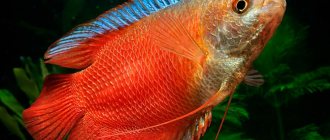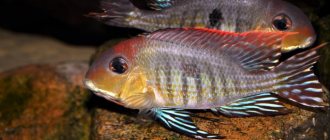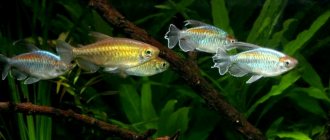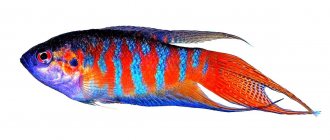Habitat in nature
Neon vulgare was first described by Gehry in 1927. They live in South America, their homeland in the region of the Paraguay, Rio Tacuari, and Brasil river basins.
In nature, blue neons prefer to inhabit slow tributaries of large rivers. These are rivers of dark water that flow through dense jungle, so that very little sunlight reaches the water. They live in flocks, live in the middle layers of water and feed on various insects.
At the moment, neons are very widely bred for commercial purposes and are practically not caught in the wild.
Motherland
Neon fish originated from South America. This is where their homeland is, where they live in clean reservoirs with soft water. They are also found in the rivers of southeastern Colombia and eastern Peru. They love shade, so they choose places with dense vegetation, where the sun's rays practically do not reach. They live in groups of 10 or more, so they should never be kept alone in an aquarium as they rely on each other.
The reservoirs of the Amazon River basin are native to neon birds.
The first neon fish imported into France in 1934 sold for $6,500.
Neon fish contents
Neon fish are an extremely unpretentious species, so even a novice aquarist can cope with their maintenance and care. They feel best in small flocks of 6-7 individuals; in this case, their color becomes as saturated as possible.
Neon fish look most beautiful against the backdrop of dense aquarium greenery and dark soil. To create the most natural conditions possible, you can add various driftwood to the aquarium.
The water temperature in the aquarium should be between 20-23°C. This greatly affects how long your neon will live. The higher the temperature, the faster the fish age, and therefore live less. In general, the average lifespan of these fish with appropriate maintenance and care is about 3-4 years . Also, aquarium water should be soft, always fresh and clean.
The volume of the aquarium for these fish can be any size. The main thing is that each individual needs at least 1 liter of water. It is necessary to have filtration and aeration systems, but regardless of this, it is recommended to change up to a quarter of the volume of water in the aquarium with fresh water weekly.
Among plants, neon fish prefers long-stemmed species, such as hornwort. When designing an aquarium, you should also remember that these agile fish need space for active swimming.
Neon fish also likes to have secluded places in the aquarium where it can hide from any danger at any time. For this purpose, various artificial caves are created or ceramic shards are placed.
An aquarium with neon lights requires diffused lighting, and it must have darkening zones. You can achieve the required level of illumination by placing groups of algae.
What and how to feed
Neons are unpretentious to food, so there are no special requirements for their feeding. It is enough to follow some simple rules:
- Give food once a day.
- Don’t forget about live food, it is needed for proper nutrition of fish.
- Once a week, do not feed them at all, give them a “hungry” day. Surprisingly, they are prone to obesity, especially females. Fish can swell to enormous sizes, as a result of which their spawning process is disrupted and they die.
- Pour in the food little by little so that it does not have time to fall to the bottom. As a rule, neons take it from the surface of the water or in its thickness.
- The food should not be too big for their small mouths.
Neon fish eat both live food and dry food equally well, so the question of what to feed the neons will not arise. If you want to pamper your pets, give them bloodworms or tubifex - this is their favorite treat. And, of course, we must remember that the diet should be varied and complete.
How to set up an aquarium for neon lights
For neons to feel comfortable, there must be a lot of water and greenery. For 4–6 fish you need an aquarium of at least 10 liters. They prefer stagnant water, so a few small bubbles will be enough for them. A compressor with a fine spray is suitable for this.
Water parameters:
- The optimal water temperature is between 18–24 degrees. By the way, the lifespan of neons directly depends on it. If at a temperature of 18 degrees they live on average 4 years, then at 27 degrees - no more than 2 years. The fact is that as the temperature of their habitat increases, their biorhythms increase. Therefore, keeping neon tanks in cool water will allow them to live longer.
- Hardness dH – 5–8, acidity pH – 5.5–6.5 – these are ideal parameters. In reality, common neon can feel fine in harder and more acidic water.
- Change water every week - 1/4–1/3 of the aquarium volume.
Neons do not need bright lighting; a cozy, dim light is enough for them. And it is not necessary to cover the aquarium; the fish are not so active that they jump out of it.
But the greens need thick and voluminous. Little “fireflies” love to scurry playfully in the lower layers of algae. The presence of dark areas, stones and snags at the bottom will bring living conditions as close as possible to the habitat habitual for neons and will help them feel “at home”. In addition, against the background of dark soil, their luminous stripe will appear brighter and more beautiful.
STORY
For the discovery of neons and their appearance in our aquariums, we should thank the French researcher Auguste Rabot. It was he who first discovered these fish in Peru, in the Putumayo River. The beauty of the fish literally bewitched Auguste. Being a very enterprising man with a touch of adventurism in his soul, he decided that he could make good money by exporting them.
In 1935, the first copies of neon were first delivered to Europe and the USA. Aquarists really immediately fell in love with these fish, they became very popular. The fact that neons did not require complex maintenance was an additional plus. Auguste Rabot received huge dividends from his find. The fact is that in artificial conditions problems arose with the breeding of neons. In the first years, no one simply succeeded, so Rabo became a monopolist in the supply of neon to Europe.
Some of the first copies were donated for advertising purposes to William Innesi, an aquarium enthusiast and popularizer. He, in turn, gave the fish to his friend, George Myers, who made the first scientific description of a new species - blue, or ordinary neon, which he named in honor of his friend.
For the first time, it was possible to obtain offspring under artificial conditions in Germany. This phenomenon was even called the “German miracle.” Over time, it became clear that the secret of this “miracle” was in the softness of the water that was used to contain neons. The information obtained served as an impetus for new research that discovered the mechanisms of influence on the successful reproduction of neons.
Proper feeding of neon fish
These fish are omnivores. In the wild, the daily diet of neons consists of all kinds of small insects, their larvae, crustaceans and worms that fall into the water column.
Like all characins, these fish are very picky about food. They will most likely consume whatever we give them, and in the quantity that is offered. But a person is not a fish, and must ensure the health of his charges.
When compiling a daily menu for neon, you should be guided by three main postulates, namely:
- moderation;
- balance;
- diversity.
Firstly, you should never overfeed your fish. If we notice bloating in the abdomen, changes in behavior, lethargy, or isolation of one or more individuals from their flock in one of our neonates, the cause of such symptoms may very well be obesity.
Overfeeding fish is detrimental to their digestive system. It should be understood that in the wild, fish have incomparably greater spatial opportunities that a river or lake provides them. Within the aquarium, their free movement is restricted by its walls.
At the same time, fish tend to obey at an unconditional level the instinct of searching for food. This is one of the main instincts of any wild animal, it has been developed over thousands of years and we cannot change anything in one sitting.
Thus, the regulation of single and daily nutritional standards for our wards falls entirely on us. Thus, let's decide how much food should be given to neons at a time, and how much per day.
A single dose should be determined through a small observation-experiment. Despite their bottom-dwelling lifestyle, neon fish rise to the surface of the water to feed, so it will not be difficult for us to observe how much food the fish eat in the first 2 minutes of feeding.
That's all. This is a normal, healthy and harmless one-time supply of food to the aquarium for your pets. The rest will most likely become surplus, the consumption of which by fish can lead to the previously described problems with their health.
The remains of excess food should be carefully removed from the surface of the water with a net, because even if the inhabitants of the aquarium do not eat it, it will begin to decompose and poison the water. This should also not be allowed.
Speaking about the daily feeding schedule for fish of this species, I will only say that it would be correct to feed neons in small portions 2-3 times a day, preferably at the same time, although this is not so important.
It would also be very appropriate to give your neons a “hungry” day once a week. This will be an excellent relief for all systems of the fish’s body, and such a maneuver on our part will only benefit them.
What to feed neons
Now let's finally talk about what to feed your fish. The diet of these fish should contain both live natural food and dry analogues.
The best live food for neons is, of course, brine shrimp, tubifex, cyclops, daphnia and bloodworms. It would be wise to grind the food before adding it to the aquarium. Feeding natural live food will provide your pets with all the necessary nutrients, such as proteins and fats, which are so necessary for mobile neons.
By the way, if it is not possible to obtain natural food for the fish, you can give them sawdust from a cow’s heart, finely planed with a blade. Neons eat such food quite happily.
You should also buy special dry food for our neon pets. By and large, dry food and granules make up the majority of the diet for almost all types of aquarium fish. The main thing is not to forget to alternate them with natural food.
When purchasing dry flake food, you should give preference to proven, well-established manufacturers on the market. Don't rely only on clever marketing and advertising. It is best to follow the recommendations of fellow aquarists, or at least read reviews and review articles on the Internet.
Dry foods such as TetraMin and NeonGran have proven themselves well. These are special flake and granular foods from popular manufacturers, which, according to the description, contain many useful substances.
At the same time, we will make some tilt towards the granules. Flakes should still be given to fish somewhat less frequently, but high-quality granulated food is suitable for daily consumption by your pets.
Kinds
Keeping neons in an aquarium attracts fans of the aquatic world not only due to their bright colors, but also due to the abundance of varieties of neons. Species that have gained popularity in the aquarium hobby:
- Blue, or common neon, is the most sought-after variety, which was first discovered by Auguste Barot. The color of the variety is bright: there is a neon line along the body, under which there is a scarlet stripe from the center of the body to the tail. Representatives grow up to 4 cm in length.
- Golden is a golden colored morph of the common variety. A stripe runs along the body, which in the light gives off a golden appearance. Representatives of the species stretch up to 4 cm in length.
- Diamond is a variety bred by breeders. The head of the phenotype is blue, with a scarlet stripe with a matte tint running along the sides. The main tone of the scales is silver with a sapphire sheen. It reaches 4 cm in length.
- Veiled is an artificially bred variety. A distinctive feature is the developed lush fins; the species is considered rare and expensive.
- Red – representatives of red neons have a rich color. Like the blue one, the red fish has a reflective stripe, under which there is a wide crimson line. The fins of the fish are transparent, the back is green.
- Black neons are aquarium fish that grow up to 4 cm. The color of the body is black-emerald, the abdomen is light. The body is decorated with two lines: silver and jet black.
- Green - In the wild, inhabits the waters of the Amazon. The main color tone is silver-green, with a green stripe along it. The tail has a dark spot with a golden dot, the fins are uncolored.
- Blue - miniature fish, growing up to 3.5 cm in length. The appearance is similar to the red or blue variety, the phenotype has a luminous blue stripe.
- Orange is a subspecies of red neon. The body is colored orange, with dark blue spots scattered throughout the body. The stripe of the orange neon is not as bright as that of other species.
- False blue - the appearance is similar to the ordinary variety, but the scarlet stripe is not so pronounced. The dominant color is blue.
Neon diseases
The most common neon disease is plastiphorosis. It is infectious in nature, the causative agent is a pathogenic fungus that parasitizes the muscular system of fish. It can be brought into the aquarium by other infected fish or untreated water.
The symptom of this disease is fading of color and body position with the tail up.
There is no treatment for plastiphorosis. They destroy not only sick individuals, but also everyone in the aquarium, since even a seemingly healthy fish can be a carrier of a harmful fungus. The aquarium is cleaned and disinfected.
Breeding
This process is quite difficult, since to implement it you need to have special water parameters in the aquarium. First of all, the water should be as soft as possible - 1-2 dGH and pH 5.0 - 6.0. This is explained by the fact that in harder water, eggs simply cannot be inseminated.
A large volume of container is not needed. For one pair, 10 liters is enough, and for several - 20. The spawning aquarium must have a sprayer and a lid, since neons can jump out. The flow, of course, should be minimal. The light level should be kept to a minimum, so it is better to cover the side walls with something (fabric, paper). The optimal temperature is 25 degrees. From plants you can use mosses, riccia and other similar species in which the female can lay eggs.
At the time of spawning, the fish need to be intensively fed with food of animal origin. The whole process takes about a week or two. It's easier to start at night. The aquarium is shaded, and then the pair is transplanted into it. The male will chase the female. She will lay hundreds of eggs on the plant. If you don’t have one at hand, a nylon washcloth will do.
Once the eggs have been produced, the pair should be immediately returned to the community aquarium, as they may eat them. Next, the water level in the spawning tank needs to be lowered to 7-10 cm and completely protected from light (for example, it can be put in a closet).
The larva appears after 4-5 days, and after another three days the fry begins to swim. It will be able to develop normally if it swallows air from the surface, due to which it thus fills the swim bladder. Therefore, the aquarist should ensure that no film appears on the surface, which could interfere with this process.
The fry's diet consists mainly of egg yolk or ciliates. Gradually, the water level needs to be increased and made harder, to the standard value.
Compatibility of neon with other fish
Neons get along well in a home pond with the following aquarium fish: Poeciliids (guppies, swordtails, mollies, platies), speckled and panda catfishes, tetras, zebrafish, labeo, rasboras, minors, gouramis, iris, pulchers, minors, and shrimp. Let's look at compatibility with some fish in more detail.
Corydoras catfish are excellent neighbors for small characins; they live together in the bottom layers of the aquarium and collect the remains of uneaten food. Corydoras are harmless fish, also small and peaceful, love to watch their neighbors without harming them.
Rasboras can be an excellent company for neons. Among them: rasboras proper, boraras, microrasboras and trigonustigmas, some of them belong to the Cyprinidae family.
Fishes of the Poeciliaceae family (guppies, molly, swordtails, platies) coexist peacefully with characins. Swordtails are also distinguished by their small body size, but males can be overly active. It should be taken into account that more than two male swordtails sometimes chase smaller neighbors, especially during the spawning period. With insufficient feeding, in cramped conditions, with a small place for swimming, swordtails become unbearable. To prevent these fish from terrorizing small neons, the aquarium must be spacious, with sufficient plants and hiding places.
Neons are not compatible with the following fish:
- Large catfish, cichlids, barbs, astronotus, bettas, koi carps - those that live in cool water or have predatory, aggressive behavior.
- Goldfish - they live in cool water and are aggressive towards brightly colored fish and their offspring.
- Angelfish - can live with neons only if they all grew up together from the age of the young. But angelfish will perceive neon strangers as food. Also, during the mating season, angelfish will be aggressive towards everyone, including these small fish.
Aquarium Basics
Blue neons are used to living in a flock of 10-12 individuals. These are peaceful fish, so they get along well with most aquarium inhabitants. They are unpretentious and are content with even a small tank not exceeding 10 liters. The water temperature must be maintained within +19…+23 °C. It is not recommended to exceed this figure, as this will reduce the life expectancy of neon. The lighting in the aquarium must be kept low, with the obligatory presence of dark places. Water hardness should be between 6 and 15 °dH. But for good spawning of fish it is necessary to reduce this coefficient by 3-5 times.
Neon gets along with all plants. The main thing is that they do not interfere with his free swimming.
You can use any mounds, caves and castles as decorations. These fish are quite nimble, but not jumping. Therefore, it is not necessary to additionally cover the aquarium with a lid.
Preparing the soil and caring for fish
The soil should be dark. As a rule, due to this, neon (fish) acquires a brighter color. These aquarium inhabitants are quite shy. It is recommended to purchase them in quantities of at least 6.
It should be remembered that neon fish, the care of which does not require special skills, unlike other inhabitants of aquariums, are susceptible to stress, therefore, when transplanted or transported, they may lose their bright coloring.
Basic rules of care:
- Aquarium fish neons need regular water changes (up to 1/3 of the volume).
- When aerating, it is not necessary to provide a water flow; it is enough to use a sprayer to form small bubbles.
- Neons need low overhead lighting. At the depth of the aquarium there should be darkness, which is created by dense vegetation.
- There is no need to cover the aquarium.
- You can put many different parts into a fish house. For example, wooden snags, stones, grottoes, etc. Everything is at the discretion of the owner.
Reproduction
The female neon has a more rounded shape than the male.
Despite the fact that neons are quite simple to maintain and care for , the process of their reproduction is quite complicated. The first difficulty that an inexperienced aquarist will have to face is poorly distinguishable sexual characteristics. Typically, the female differs from the male in its larger body size, in particular, it has a more voluminous abdomen.
They can also be distinguished by a blue stripe that stretches along the entire body. In the male it is usually straight, while in the female it is curved in the abdomen area. But all these signs are rather conditional. Therefore, for reproduction it is necessary to plant a whole group of neons at once .
Preparing the spawning tank and spawning
An aquarium with a volume of no more than 10 liters can be used as a spawning ground. It is desirable that it be elongated and low, its height should not exceed 30 cm. The second difficulty in breeding neons is that the eggs are too sensitive and delicate, which die even with the slightest deviation from the norm.
To preserve future offspring, place a net on the bottom of the spawning aquarium.
The water in the spawning area must be very soft and perfectly clean. It should be free of even the slightest impurities or chemicals. Even if its rigidity is increased even slightly, the eggs are immediately covered with a dense crust, which prevents their fertilization. This is the main reason why it will not be possible to breed fry in a community aquarium.
Also, for successful spawning, it is necessary to place a pinnate bush or, in its absence, a piece of tangled fishing line in the spawning area. This will serve as an additional measure to protect the caviar, since very often parents try to eat it.
To prepare selected males and females for spawning, they are placed in a separate darkened aquarium. The water temperature in it should be maintained at +25°C. Several males can be placed with one female at once.
To stimulate spawning, the released fish should be fed more abundantly, using mosquito larvae for this. You should also reduce the hardness and nitrate levels in the water as much as possible. This can be achieved by daily replacing water by half of the total volume. This technique simulates the onset of the rainy season in the natural habitat of neons, during which they begin spawning.
After such preparation, the producers are transplanted to the spawning area. It is best to do this in the late afternoon. If all conditions have been met, then by morning the spawning process begins. Sometimes spawning can begin on the second or third day after transplantation.
Video: Neon Spawning
You should not feed the fish during spawning. At one time, the female, depending on her condition, can lay up to 200 eggs. Immediately after the end of spawning, both the male and female are separated, since they can eat the eggs .
Caring for eggs and fry
After depositing the breeder, the aquarium is darkened; bright light is detrimental to the eggs. Also, you need to monitor the condition of the caviar for the next few hours. If white eggs are found, they should be removed using tweezers. If this is not done, they will continue to decompose and will lead to the death of viable eggs.
The photo shows a very tiny neon.
After about a day, the eggs will begin to hatch into larvae, which will remain stationary for the next 3-4 days. Around the fifth day of life, they will gain the ability to move independently and begin to eat.
After this, you need to hang a light source above the aquarium. You can also start feeding the fry. At first, you can use ciliates or rotifers as food for them. You can also purchase special ready-made food for raising fry or prepare your own mixture from mashed boiled yolk.
A compressor must be installed in an aquarium with fry . And the temperature in it is maintained at 20-22°C. It is also necessary to change some of the water daily with new water. At the same time, it is worth gradually increasing its rigidity. This will prepare the fry for life in a community aquarium.
Aquarium preparation
Before introducing fish, prepare the tank:
- Neon fish do not need current; they prefer backwaters. Equip the container with a compressor device that produces a fine spray of air. The smaller the size of the bubbles formed, the more comfortable the aquarium fish feels.
- pour settled water with an acidity of up to 6.5 and a hardness of up to 8. These are optimal indicators for fish. But even with increased parameters, the fish live well in the container.
- For neons in an aquarium, a water change is important. This should be done weekly. A quarter of the tank volume must be replaced. The water should be left to stand for several days in advance.
Look at these neon beauties.
- Neons love dense vegetation. Purchase plants for all layers of the tank. Fish swim in the bottom part of the aquarium; they are very active and often play games while swimming in the upper layers.
- an aquarium with fish does not need additional lighting. Neon dwellers love dim lighting.
- the filter can be installed as desired. The neon fish will get along without it, especially if there are snails in the aquarium.
- Shave primer for decoration in dark colors. It sets off the neon stripe on the body.
- Place hiding places for neons in the aquarium. These can be large stones, driftwood, grottoes. Thus, the habitat will be close to natural.
Having equipped the aquarium, proceed to selecting fish.

